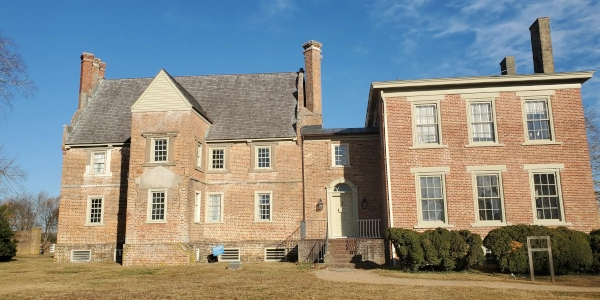
Image above: Statue of Medgar Evers at Alcorn State University, 2017, Carol M. Highsmith. Courtesy Library of Congress.
Spotlight on Lesser Known History
Medgar and Myrlie Evers Home National Monument
Mississippi
America's Best History Spotlight
On this page we're going to Spotlight the lesser known historic sites and attractions that dot the history landscape across the USA and are worth a visit if you're in their area. And while they may be lesser known, some are very unique, and will be that rare find. You'll be, at times, on the ground floor, or maybe even know something others don't. It'll be fun. Visit them.
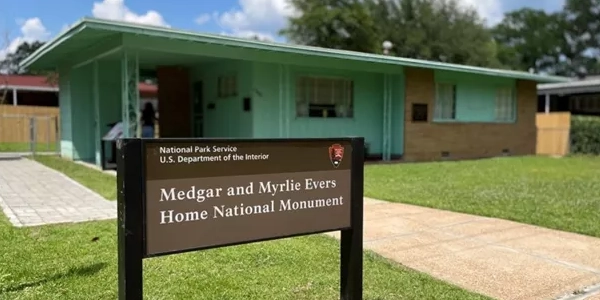
Medgar and Myrlie Evers Home National Monument, Mississippi
Medgar and Myrlie Evers were Civil Rights activists from the early 1950's, colleagues with Dr. Martin Luther King and others. However, it was not until tragedy hit on June 12, 1963, that their names would be synonymous, if not less known, then there more famous colleagues who would eventually recieve the same fate. That was the day the first black Civil Rights Activist was murdered, Medgar Evers, in the carport/driveway of his home by a white supremacist, Byron De La Beckwith. That will be the last time his name will be mentioned. Through the next decade, more would be killed by the Klu Klux Klan and their allies. The recognition of these acts has now led to the establishment of National Monuments that tell that story. This one, the Medgar and Myrlie Evers Home National Monument was established by President Donald Trump on December 10, 2020 and through the John Dingall Act of March 12, 2019. The house was bought from Tougaloo College. It is now open to visit three days a week.
Photo above: Photo of front of Medgar and Myrlie Evers Home National Monument, National Park Service.
Sponsor this page for $100 per year. Your banner or text ad can fill the space above.
Click here to Sponsor the page and how to reserve your ad.
Info, What's There Now, History Nearby

Medgar and Myrlie Evers Home National Monument, Mississippi
Medgar Evers was a product of the segregated south, educated at Alcorn A&M College, now Alcorn State University, and served, again in the segregated United States Army from 1943 through World War II until his discharge at the rank of seargant in 1945. His involvement in the Civil Rights movement began with his part in the organization of NAACP chapters in the state, rising to the level of the first field secretary of the NAACP in Mississippi. At that time, his name had risen in both positive and negative circles. The White Supremacist movement now knew of his efforts to disegregate the University of Mississippi after the Supreme Court's Brown vs. Education decision in 1954. His effort would take until 1962 when James Meredith became the first black student at the university. That effort, as well as his involvement in the investigation into the death of Emmitt Till heightened the anti-segregationalists to up their ire toward Evers. A Molotov cocktail was thrown into his carport on May 28, 1963; Evers was attempted to be run over by a car leaving the NAACP office on June 7, 1963. He was murdered five days later on the day President John F. Kennedy gave his Civil Rights Address. Myrlie Evers would be the first to find him.
Image above: Wedding Photo of Medgar and Myrlie Evers. Courtesy National Park Service. Below: Demonstration in Washington, D.C. over Civil Rights and the murder of Medgar Evers in the driveway of his home, 1963, Warren K. Leffler. Courtesy Library of Congress.

Where Is It
Medgar and Myrlie Evers Home National Monument is located at 2332 Margaret W Alexander Drive, Jackson, Mississippi, 39213. There are two locations right near each other, including the home where Medgar was murdered and Myrlie's garden across Missouri Street a small walk down the street. The historic district includes those two locations as well as the entire block and a bit beyond. Check your favorite GPS program for the best way to get there.
What is There Now
Medgar and Myrlie Evers Home NM
The home where Medgar and Myrlie lived until the tragic murder of Medgar in the carport of their home as well as her garden down the street now pleasantly adorned with picnic areas and a garden close to that which she tended. There are tours of the home. It is small, only ten people per tour, so best to call ahead for a reservation or at least to gage the demand. Since this is a new park, a full plan has yet to be developed. There are currently no restrooms.
When Open and How Much
No fee. The site is open on Wednesdays, Fridays, and Saturdays from 10-12 and 2-4 pm. There is limited parking on the street, which is still an active neighborhood. More parking is located near Myrlie's Garden.
Fees and hours are subject to change.
Websites
Medgar and Myrlie Evers Home National Monument
History Nearby
Jackson, Mississippi and the surrounding area includes many important historic and recreation sites for you to visit. In Jackson, there is the Old Capitol Museum, Eudora Welty House and Garden, the Mississippi State Freedom Trail, the Mississippi Civil Rights Museum, and the Mississippi Museum of Natural Science, including an aquarium. For other national park sites a bit further afield, you have Vicksburg Battlefield, Shiloh, Gulf Islands National Seashore, and the Natchez Trace Parkway.
Photos, History, and More Spotlights
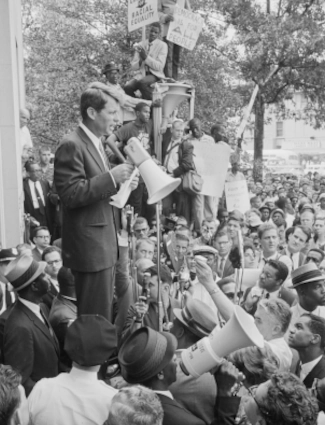
Civil Rights Demonstration
The response to his assassination reverberated throughout the United States. Demonstrations were held throughout the south and in Washington, D.C. where Attorney General Robert F. Kennedy spoke passionately about his death and the campaign for Civil Rights. By June 19, 1963, President John F. Kennedy introduced his Civil Rights Act to Congress. Its tenants were immeasurable, if not imperfect into moving the nation toward more equality. It outlawed discrimination according to race, color, religion, sex, or national origin, as well as unequal voter registration requirements, discrimination in public accommodations and public facilities. There was considerable debate. When President Kennedy himself was assasinated that November, the effort picked up steam again. His successor, President Lyndon Baines Johnson signed the Civil Rights Act into law on July 2, 1964.
Photo above: Attorney General Robert F. Kennedy speaking at rally and demonstration after death of Medgar Evers, 1963, Warren K. Leffler. Courtesy Library of Congress.
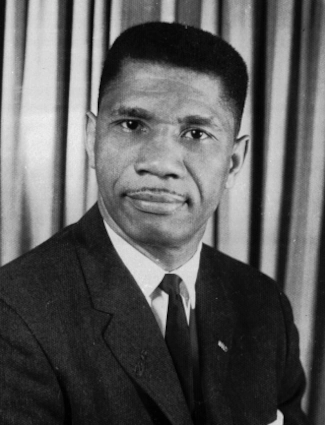
Medgar Evers
Additional details on the meritorious life of Medgar. He was born in Decatur, Mississippi on July 2, 1925. His service in the Army during World War II took him to the European theater through the invasion of Normandy. His marriage to Myrlie Beasley occurred On December 24, 1951; they would have three children. At this time, Medgar worked for the T. R. M. Howard's Magnolia Mutual Life Insurance Company as a salesman. Howard was a huge supporter of Civil Rights, founding the Regional Council of Negro Leadership.
Medgar and Mylie Evers bought the house at 2332 Margaret Walker Alexander Drive in northern Jackson, Mississippi in 1956, part of a planned community for black citizens known as the Elraine Subdivision. The subdivision and neighborhood still exists much like it did over sixty years ago.
Image above: Photo of Medgar Evers, 1963, Unknown photographer. Courtesy Wikipedia Commons.
Buy Second Edition
America's Best History Timeline

Great book to keep middle school to college students up to date on their American history.
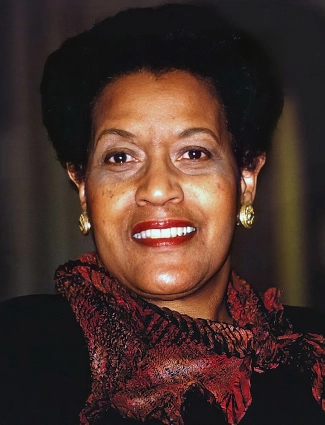
Myrlie Evers
Myrlie Beasley enrolled at Alcorn A&M College, studying education with a minor in music, and met Medgar Evers on the first day of classes, fell in love, and eventually married. She worked as a secretary at the Magnolia Mutual Life Insurance Company aside her husband. Though his increased exposure as a Civil Rights leader was oppossed by his parents, Myrlie worked alongside him in their efforts to expand the NAACP and make positive changes for their community through community activism. In 1962, their home was firebombed. By 1963, there were calls by the KKK that Evers should be a target.
After his assasination, Myrlie Evers fought hard for the conviction of his killer, whose first trial ended in April 1964 with an acquittal by an all white jury. For decades, Myrlie Evers pushed for a conviction and continued as as activist for Civil Rights. On February 5, 1994, thirty years later, the man who assassinated Medgar Evers was convicted of the crime. Myrlie Evers would become the chairperson of the NAACP in 1995.
Photo above: Photo of Myrlie Evers continuing her Civil Rights campaign, 2000, John Mathew Smith. Courtesy Wikipedia Commons C.C. 2.0. Below: Muylie Evers Garden at the National Monument. Courtesy National Park Service.
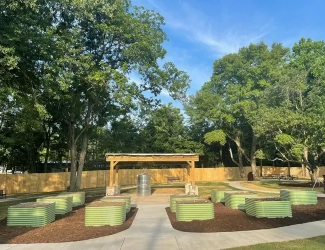

T-Shirts and Gifts from the official souvenirs of Americasbesthistory.com.
About
America's Best History where we take a look at the timeline of American History and the historic sites and national parks that hold that history within their lands.
Photos courtesy of the Library of Congress, National Archives, National Park Service, americasbesthistory.com and its licensors.
- Contact Us
- About
- © 2024 Americasbesthistory.com.
Template by w3layouts.


